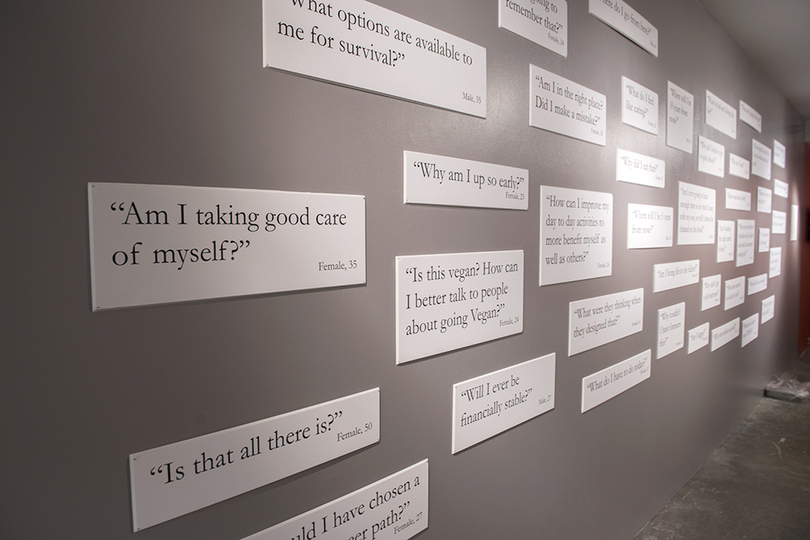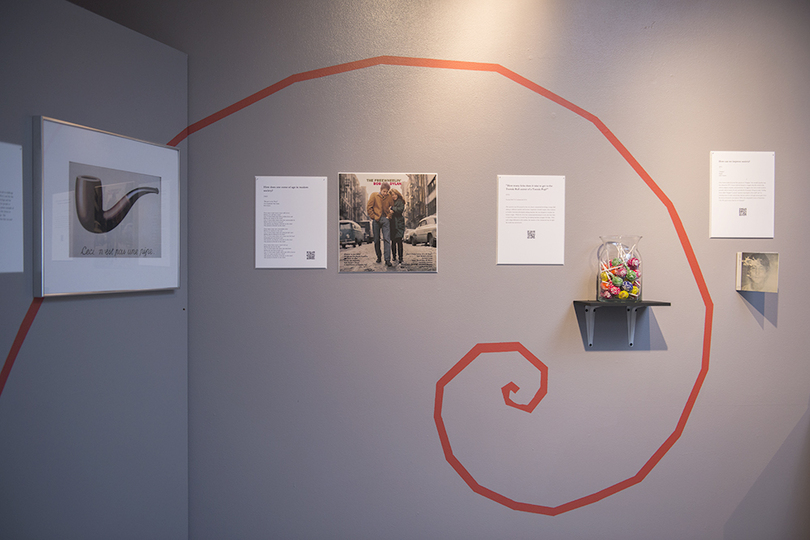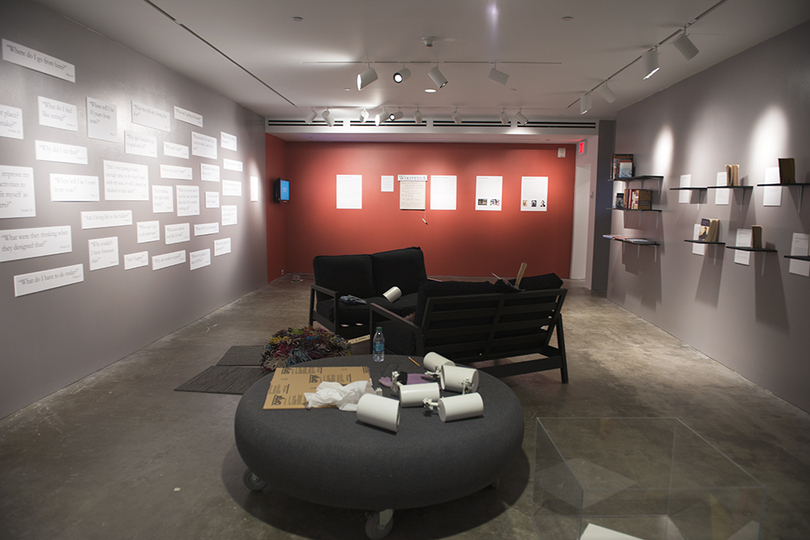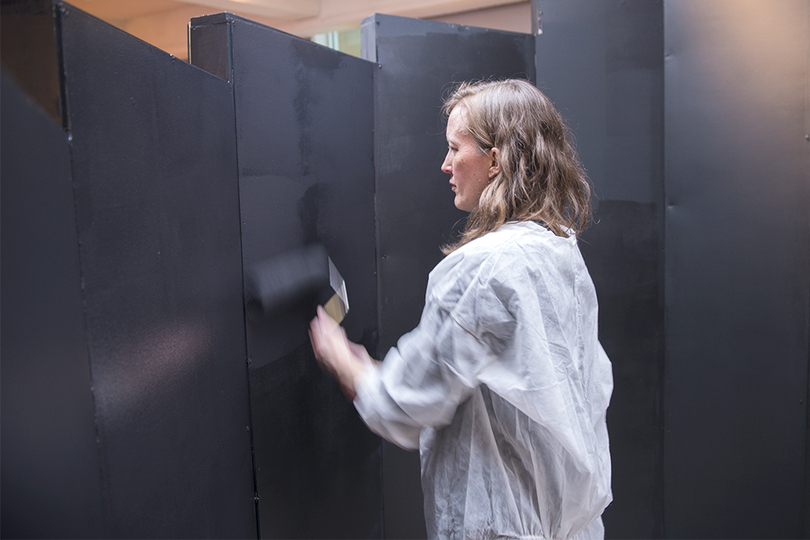That is the question: Graduate students put together exhibit exploring power of learning through questioning
As visitors walk around a giant wooden spiral in the center of a new art exhibit at The Warehouse, they are challenged to consider the significance of questioning on a conceptual journey.
The 9-foot spiral is just one of numerous objects in the exhibit that aim to get people to analyze and relate to the human experience of questioning, said Renee Storiale, the exhibit curator.
The exhibit, called “FAQ: Fearlessly Asked Questions,” is meant to encourage people to consider questioning as a common thread between all people that can inspire change.
“Questioning is something we often take for granted,” Storiale said. “It’s valuable to stop and realize that we are all questioning things, and a lot of that involves relating to others.”
Storiale is a museum studies graduate student in the College of Visual and Performing Arts. A practicum class in the first-year museum studies graduate program of VPA that Storiale is taking allowed her and other museum studies students to create the exhibit.
This full-year practicum course involves creating multiple exhibits throughout both the spring and fall semester. But this exhibit is much more abstract and intellectually focused than other projects the class has worked on, Storiale said.
“Our other exhibits were more object-focused,” Storiale said. “This one is more cerebral.”
The exhibit is divided into two parts, each with its own room. In the first part, visitors walk through the north side of the exhibit, which includes objects intended to inspire people to have the courage to question the world around them.
The second focuses on actually motivating visitors to answer their own individual questions and start the process of positive change, Storiale said.
The north room focuses on the origin of questions with artwork that represents famous questions asked throughout history, such as the black spiral inspired by Fibonacci’s Spiral, said Storiale.
This famous geometric spiral, often found in nature for unclear reasons, represents how questioning and learning are ongoing, so it has evolved into a symbol of the exhibit, she said.
As visitors move through the section that is centered on Fibonacci’s black spiral, the questions become more contemporary.
“When we we’re thinking about the journey, we want visitors to take from the remote, distant questions to the close, personal ones,” Storiale said. “We looked at the shape of the question mark itself and how it gets more narrow.”
Pieces in this part of the exhibit are meant to spark reflection about questioning and answering, first in historical terms and then on a more personal level, Storiale said. Artifacts that visitors first encounter include a model of a 16th century telescope. As they move farther into the exhibit, the pieces become more contemporary.
The final objects that visitors encounter relate to an anonymous survey taken by about 100 people that was conducted by the class. The survey asked people for questions they encounter on a daily basis.
The students then chose their favorite survey responses to be featured in the exhibit. The people who contributed these responses were notified and asked to donate an object related to their survey response.
These objects, paired with the questions chosen, became part of the exhibit. For instance, a frying pan accompanies the question, “What am I having for dinner this evening?”
Another notable example is a newspaper clipping that was donated to go with the question, “Where will I be in 10 years?,” Storiale said.
The objects in the exhibit are cross-disciplinary, she said. She and the other curator, Steffi Chappell, tried to incorporate questions from science, math, philosophy, literature, art history, pop culture and individuals at Syracuse University.
The conceptual nature of the exhibit made it challenging to construct physically, said Monique Wilkins, another museum studies graduate student in the class and one of the physical designers of the exhibit.
“I think everyone can say we’ve taken it up a notch,” Wilkins said. “I think the exhibit will set a standard in this program to maybe do some more conceptual work.”
Many aspects of the design have been changed dramatically since the beginning of its construction in November, she added.
However, having the spiral as the centerpiece of the exhibit has remained constant, she said.
The second part of the exhibit, referred to as the south end, is focused on inspiring visitors to consider the process of answering questions.
It is an open room with tools to inspire gallery visitors to answer their personal questions, such as bookcases and a giant chalkboard.
This room also features a wall filled with answers collected from the survey the class conducted to make the class seem more relatable to visitors, Storiale said.
Incorporating questions and answers from individuals currently living today is meant to make visitors consider questions on both a societal and personal level, said Erica Jensen, a student in the class who worked on constructing the gallery and promoting it across campus.
On Friday from 5 p.m.-8 p.m., there will be a reception at The Warehouse following the grand opening of the exhibit, Jensen said. From 5:30 p.m.-6:15 p.m. at the reception, a panel discussion will feature input from a variety of professionals in the museum industry, including Dr. Pam McLaughlin, curator of education and public programs at the Everson Museum of Art, and Steve Masiclat, director of graduate program and new media, she added.
If students are interested and cannot make it to the exhibit, they can go to the “FAQ” exhibit interactive website that features recordings about pieces in the exhibit. The site allows individuals to record feedback about the exhibit after hearing about the inspiration for each piece.
Of all of the exhibits the class has worked on this year, Jenson said this exhibit has involved the most work and input by the class itself.
“This is different because it’s coming from us,” she said. “It’s really a culmination of our year. ”
Published on April 11, 2013 at 12:25 am
Contact Shannon: smhazlit@syr.edu









